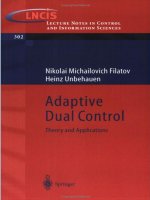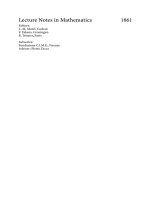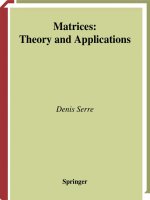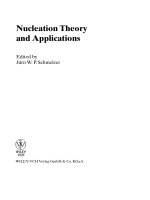matrices theory and applications - serre d.
Bạn đang xem bản rút gọn của tài liệu. Xem và tải ngay bản đầy đủ của tài liệu tại đây (1.14 MB, 219 trang )
Matrices:
Theory and Applications
Denis Serre
Springer
Graduate Texts in Mathematics 216
Editorial Board
S. Axler F.W. Gehring K.A. Ribet
This page intentionally left blank
Denis Serre
Matrices
Theory and Applications
Denis Serre
Ecole Normale Supe
´
rieure de Lyon
UMPA
Lyon Cedex 07, F-69364
France
Editorial Board:
S. Axler F.W. Gehring K.A. Ribet
Mathematics Department Mathematics Department Mathematics Department
San Francisco State East Hall University of California,
University University of Michigan Berkeley
San Francisco, CA 94132 Ann Arbor, MI 48109 Berkeley, CA 94720-3840
USA USA USA
Mathematics Subject Classification (2000): 15-01
Library of Congress Cataloging-in-Publication Data
Serre, D. (Denis)
[Matrices. English.]
Matrices : theory and applications / Denis Serre.
p. cm.—(Graduate texts in mathematics ; 216)
Includes bibliographical references and index.
ISBN 0-387-95460-0 (alk. paper)
1. Matrices I. Title. II. Series.
QA188 .S4713 2002
512.9′434—dc21 2002022926
ISBN 0-387-95460-0 Printed on acid-free paper.
Translated from Les Matrices: The
´
orie et pratique, published by Dunod (Paris), 2001.
2002 Springer-Verlag New York, Inc.
All rights reserved. This work may not be translated or copied in whole or in part without the
written permission of the publisher (Springer-Verlag New York, Inc., 175 Fifth Avenue, New York,
NY 10010, USA), except for brief excerpts in connection with reviews or scholarly analysis. Use
in connection with any form of information storage and retrieval, electronic adaptation, computer
software, or by similar or dissimilar methodology now known or hereafter developed is forbidden.
The use in this publication of trade names, trademarks, service marks, and similar terms, even if
they are not identified as such, is not to be taken as an expression of opinion as to whether or not
they are subject to proprietary rights.
Printed in the United States of America.
987654321 SPIN 10869456
Typesetting: Pages created by the author in LaTeX2e.
www.springer-ny.com
Springer-Verlag New York Berlin Heidelberg
A member of BertelsmannSpringer Science+Business Media GmbH
To Pascale and Joachim
This page intentionally left blank
Preface
The study of matrices occupies a singular place within mathematics. It
is still an area of active research, and it is used by every mathematician
and by many scientists working in various specialities. Several examples
illustrate its versatility:
• Scientific computing libraries began growing around matrix calculus.
As a matter of fact, the discretization of partial differential operators
is an endless source of linear finite-dimensional problems.
• At a discrete level, the maximum principle is related to nonnegative
matrices.
• Control theory and stabilization of systems with finitely many degrees
of freedom involve spectral analysis of matrices.
• The discrete Fourier transform, including the fast Fourier transform,
makes use of Toeplitz matrices.
• Statistics is widely based on correlation matrices.
• The generalized inverse is involved in least-squares approximation.
• Symmetric matrices are inertia, deformation, or viscous tensors in
continuum mechanics.
• Markov processes involve stochastic or bistochastic matrices.
• Graphs can be described in a useful way by square matrices.
viii Preface
• Quantum chemistry is intimately related to matrix groups and their
representations.
• The case of quantum mechanics is especially interesting: Observables
are Hermitian operators, their eigenvalues are energy levels. In the
early years, quantum mechanics was called “mechanics of matrices,”
and it has now given rise to the development of the theory of large
random matrices. See [23] for a thorough account of this fashionable
topic.
This text was conceived during the years 1998–2001, on the occasion of
a course that I taught at the
´
Ecole Normale Sup´erieure de Lyon. As such,
every result is accompanied by a detailed proof. During this course I tried
to investigate all the principal mathematical aspects of matrices: algebraic,
geometric, and analytic.
In some sense, this is not a specialized book. For instance, it is not as
detailed as [19] concerning numerics, or as [35] on eigenvalue problems,
or as [21] about Weyl-type inequalities. But it covers, at a slightly higher
than basic level, all these aspects, and is therefore well suited for a gradu-
ate program. Students attracted by more advanced material will find one
or two deeper results in each chapter but the first one, given with full
proofs. They will also find further information in about the half of the
170 exercises. The solutions for exercises are available on the author’s site
˜serre/exercises.pdf.
This book is organized into ten chapters. The first three contain the
basics of matrix theory and should be known by almost every graduate
student in any mathematical field. The other parts can be read more or
less independently of each other. However, exercises in a given chapter
sometimes refer to the material introduced in another one.
This text was first published in French by Masson (Paris) in 2000, under
the title Les Matrices: th´eorie et pratique. I have taken the opportunity
during the translation process to correct typos and errors, to index a list
of symbols, to rewrite some unclear paragraphs, and to add a modest
amount of material and exercises. In particular, I added three sections,
concerning alternate matrices, the singular value decomposition, and the
Moore–Penrose generalized inverse. Therefore, this edition differs from the
French one by about 10 percent of the contents.
Acknowledgments. Many thanks to the Ecole Normale Sup´erieure de Lyon
and to my colleagues who have had to put up with my talking to them
so often about matrices. Special thanks to Sylvie Benzoni for her constant
interest and useful comments.
Lyon, France Denis Serre
December 2001
Contents
Preface vii
List of Symbols xiii
1ElementaryTheory 1
1.1 Basics 1
1.2 ChangeofBasis 8
1.3 Exercises 13
2 Square Matrices 15
2.1 DeterminantsandMinors 15
2.2 Invertibility . . . . . . . . . . . . . . . . . . . . . . . . . 19
2.3 AlternateMatricesandthePfaffian 21
2.4 EigenvaluesandEigenvectors 23
2.5 TheCharacteristicPolynomial 24
2.6 Diagonalization . . . . . . . . . . . . . . . . . . . . . . . 28
2.7 Trigonalization 29
2.8 Irreducibility . . . . . . . . . . . . . . . . . . . . . . . . . 30
2.9 Exercises 31
3 Matrices with Real or Complex Entries 40
3.1 Eigenvalues of Real- and Complex-Valued Matrices . . . 43
3.2 SpectralDecompositionofNormalMatrices 45
3.3 Normal and Symmetric Real-Valued Matrices . . . . . . 47
xContents
3.4 The Spectrum and the Diagonal of Hermitian Matrices . 51
3.5 Exercises 55
4 Norms 61
4.1 ABriefReview 61
4.2 Householder’sTheorem 66
4.3 AnInterpolationInequality 67
4.4 A Lemma about Banach Algebras . . . . . . . . . . . . . 70
4.5 TheGershgorinDomain 71
4.6 Exercises 73
5 Nonnegative Matrices 80
5.1 NonnegativeVectorsandMatrices 80
5.2 The Perron–Frobenius Theorem: Weak Form . . . . . . . 81
5.3 The Perron–Frobenius Theorem: Strong Form . . . . . . 82
5.4 CyclicMatrices 85
5.5 StochasticMatrices 87
5.6 Exercises 91
6 Matrices with Entries in a Principal Ideal Domain;
Jordan Reduction 97
6.1 Rings,PrincipalIdealDomains 97
6.2 Invariant Factors of a Matrix . . . . . . . . . . . . . . . . 101
6.3 Similarity Invariants and Jordan Reduction . . . . . . . 104
6.4 Exercises 111
7 Exponential of a Matrix, Polar Decomposition, and
Classical Groups 114
7.1 ThePolarDecomposition 114
7.2 Exponential of a Matrix . . . . . . . . . . . . . . . . . . 116
7.3 Structure of Classical Groups . . . . . . . . . . . . . . . 120
7.4 The Groups U(p, q) 122
7.5 The Orthogonal Groups O(p, q) 123
7.6 The Symplectic Group Sp
n
127
7.7 Singular Value Decomposition . . . . . . . . . . . . . . . 128
7.8 Exercises 130
8 Matrix Factorizations 136
8.1 The LU Factorization 137
8.2 CholeskiFactorization 142
8.3 The QR Factorization 143
8.4 The Moore–Penrose Generalized Inverse . . . . . . . . . 145
8.5 Exercises 147
9 Iterative Methods for Linear Problems 149
Contents xi
9.1 A Convergence Criterion . . . . . . . . . . . . . . . . . . 150
9.2 BasicMethods 151
9.3 TwoCasesofConvergence 153
9.4 The Tridiagonal Case . . . . . . . . . . . . . . . . . . . . 155
9.5 The Method of the Conjugate Gradient . . . . . . . . . . 159
9.6 Exercises 165
10 Approximation of Eigenvalues 168
10.1 HessenbergMatrices 169
10.2 The QR Method 173
10.3 TheJacobiMethod 180
10.4 ThePowerMethods 184
10.5 Leverrier’sMethod 188
10.6 Exercises 190
References 195
Index 199
This page intentionally left blank
List of Symbols
|A|,80
a|b,97
A ◦ B,59
A
†
, 145
A ≥ 0, 80
a ≺ b,52
a ∼ b,97
A
∗
, 15, 97
B ⊗C,13
(b), 97
B
P
, 106
C
n
,33
C
r
,83
∆
n
,87
δ
j
i
,5
det M ,16
D
i
,71
diag(d
1
, ,d
n
), 5
dim E,3
dim
K
F ,3
D
k
(N), 102
e,87
e
i
,3
E
K
(λ), 28
E
λ
,29
End(E), 7
(σ), 16
exp A, 116
F + G,2
F ⊕ G,3
F ⊕
⊥
G,12
F
⊥
,11
G, 152
G, 121
G(A), 71
G
α
, 125
G
CC
,3
gcd, 98
GL
n
(A), 20
G
0
, 126
H ≥ h,42
H ≥ 0
n
,42
H
n
,41
HPD
n
,42
√
H, 115
, imaginary part, 56
xiv List of Symbols
I
n
,5
J, 151
J(a; r), 110
J
ik
, 100
J
2
, 132
J
3
, 132
J
4
, 132
K(A), 162
K,4
ker M,7
ker u,7
K
I
,2
K(M), 6
K
n
,57
K[X], 15
k[X, Y ], 99
λ
k
(A), 57
L(E,F), 7
L
ω
, 152
adj M ,17
¯
M,40
ˆ
M,17
M
i
1
i
2
··· i
p
j
1
j
2
··· j
p
,17
M
k
,6
M
−1
,20
M
−k
,20
M
−T
,20
[M,N], 6
M
n
(K), 5
M
n×m
(K), 5
M
∗
,40
M
−∗
,40
M
T
,10
A ,64
A
p
,65
x
p
,61
x
A
, 154
x
∞
,61
·
,64
||| · |||,65
ω
J
, 158
0
n
,5
O
n
(K), 20
0
nm
,5
O
−
n
, 123
O(p, q), 120
⊥
A
, 160
Pf, 22
P
G
, 156
π
0
, 125
P
J
, 156
P
M
,24
P
ω
, 156
p
,62
PSL
2
(IR), 56
R
A
(F ), 57
rk M ,5
, real part, 63
R(h; A), 92
ρ(A), 61
R(M ), 8
r(x), 70, 160
x, y, 11, 41
S∆
n
,90
σ
r
, 188
s
j
(A), 75
s
k
(a), 52
SL
n
(A), 20
s
m
, 189
S
n
,15
SO
n
(K), 20
S
1
,86
Sp(M), 24
Sp
K
(M), 24
SPD
n
,42
Sp
m
, 120
Sp
m
, 120
S
2
, 56, 126
SU
n
,41
Sym
n
(K), 10
τ , 151
τ
CG
, 164
T
k
, 162
Tr M,25
U
n
,41
U
p
,85
List of Symbols xv
U(p, q), 120
u
∗
,42
u
T
,11
V (a), 173
|x|,80
x ≤ y,80
x>0, 80
x ≥ 0, 80
This page intentionally left blank
1
Elementary Theory
1.1 Basics
1.1.1 Vectors and Scalars
Fields. Let (K, +, ·)beafield.ItcouldbeIR, the field of real numbers, CC
(complex numbers), or, more rarely, QQ (rational numbers). Other choices
are possible, of course. The elements of K are called scalars.
Given a field k, one may build larger fields containing k: algebraic ex-
tensions k(α
1
, ,α
n
), fields of rational fractions k(X
1
, ,X
n
), fields of
formal power series k[[X
1
, ,X
n
]]. Since they are rarely used in this book,
we do not define them and let the reader consult his or her favorite textbook
on abstract algebra.
The digits 0 and 1 have the usual meaning in a field K, with 0 + x =
1 · x = x. Let us consider the subring ZZ1, composed of all sums (possibly
empty) of the form ±(1 + ···+1).ThenZZ1 is isomorphic to either ZZ or
toafieldZZ/pZZ. In the latter case, p is a prime number, and we call it the
characteristic of K. In the former case, K is said to have characteristic 0.
Vector spaces. Let (E,+) be a commutative group. Since E is usually
not a subset of K, it is an abuse of notation that we use + for the additive
laws of both E and K. Finally, let
(a, x) → ax,
K ×E → E,
2 1. Elementary Theory
be a map such that
(a + b)x = ax + bx, a(x + y)=ax + ay.
One says that E is a vector space over K (one often speaks of a K-vector
space) if moreover,
a(bx)=(ab)x, 1x = x,
hold for all a, b ∈ K and x ∈ E. The elements of E are called vectors.Ina
vector space one always has 0x = 0 (more precisely, 0
K
x =0
E
).
When P, Q ⊂ K and F, G ⊂ E, one denotes by PQ (respectively P +
Q, F +G, P F ) the set of products pq as (p, q) ranges over P ×Q (respectively
p+q, f+g, pf as p, q, f, g range over P, Q, F, G). A subgroup (F, +) of (E,+)
that is stable under multiplication by scalars, i.e., such that KF ⊂ F ,is
again a K-vector space. One says that it is a linear subspace of E,orjusta
subspace. Observe that F , as a subgroup, is nonempty, since it contains 0
E
.
The intersection of any family of linear subspaces is a linear subspace. The
sum F + G of two linear subspaces is again a linear subspace. The trivial
formula (F + G)+H = F +(G + H) allows us to define unambiguously
F + G + H and, by induction, the sum of any finite family of subsets of E.
When these subsets are linear subspaces, their sum is also a linear subspace.
Let I be a set. One denotes by K
I
the set of maps a =(a
i
)
i∈I
: I → K
where only finitely many of the a
i
’s are nonzero. This set is naturally
endowed with a K-vector space structure, by the addition and product
laws
(a + b)
i
:= a
i
+ b
i
, (λa)
i
:= λa
i
.
Let E be a vector space and let i → f
i
be a map from I to E.Alinear
combination of (f
i
)
i∈I
is a sum
i∈I
a
i
f
i
,
where the a
i
’s are scalars, only finitely many of which are nonzero (in other
words, (a
i
)
i∈I
∈ K
I
). This sum involves only finitely many terms. It is a
vector of E. The family (f
i
)
i∈I
is free if every linear combination but the
trivial one (when all coefficients are zero) is nonzero. It is a generating
family if every vector of E is a linear combination of its elements. In other
words, (f
i
)
i∈I
is free (respectively generating) if the map
K
I
→ E,
(a
i
)
i∈I
→
i∈I
a
i
f
i
,
is injective (respectively onto). Last, one says that (f
i
)
i∈I
is a basis of E if
it is free and generating. In that case, the above map is bijective, and it is
actually an isomorphism between vector spaces.
1.1. Basics 3
If G⊂E, one often identifies G and the associated family (g)
g∈G
.Theset
G of linear combinations of elements of G is a linear subspace E, called the
linear subspace spanned by G. It is the smallest linear subspace E containing
G, equal to the intersection of all linear subspaces containing G. The subset
G is generating when G = E.
One can prove that every K-vector space admits at least one basis. In
the most general setting, this is a consequence of the axiom of choice.
All the bases of E have the same cardinality, which is therefore called the
dimension of E, denoted by dim E. The dimension is an upper (respectively
a lower) bound for the cardinality of free (respectively generating) families.
In this book we shall only use finite-dimensional vector spaces. If F, G are
two linear subspaces of E, the following formula holds:
dim F +dimG =dimF ∩ G +dim(F + G).
If F ∩ G = {0},onewritesF ⊕ G instead of F + G, and one says that F
and G are in direct sum. One has then
dim F ⊕ G =dimF +dimG.
Given a set I, the family (e
i
)
i∈I
, defined by
(e
i
)
j
=
0,j= i,
1,j= i,
is a basis of K
I
, called the canonical basis. The dimension of K
I
is therefore
equal to the cardinality of I.
In a vector space, every generating family contains at least one basis of
E. Similarly, given a free family, it is contained in at least one basis of E.
This is the incomplete basis theorem.
Let L be a field and K a subfield of L.IfF is an L-vector space, then F
is also a K-vector space. As a matter of fact, L is itself a K-vector space,
and one has
dim
K
F =dim
L
F · dim
K
L.
The most common example (the only one that we shall consider) is K = IR,
L = CC,forwhichwehave
dim
IR
F =2dim
CC
F.
Conversely, if G is an IR-vector space, one builds its complexification G
CC
as follows:
G
CC
= G ×G,
with the induced structure of an additive group. An element (x, y)ofG
CC
is also denoted x + iy. One defines multiplication by a complex number by
(λ = a + ib, z = x + iy) → λz := (ax − by, ay + bx).
4 1. Elementary Theory
One verifies easily that G
CC
is a CC-vector space, with
dim
CC
G
CC
=dim
IR
G.
Furthermore, G may be identified with an IR-linear subspace of G
CC
by
x → (x, 0).
Under this identification, one has G
CC
= G + iG. In a more general setting,
one may consider two fields K and L with K ⊂ L, instead of IR and CC,but
the construction of G
L
is more delicate and involves the notion of tensor
product. We shall not use it in this book.
One says that a polynomial P ∈ L[X] splits over L if it can be written
as a product of the form
a
r
i=1
(X −a
i
)
n
i
,a,a
i
∈ L, r ∈ IN, n
i
∈ IN
∗
.
Such a factorization is unique, up to the order of the factors. A field L in
which every nonconstant polynomial P ∈ L[X] admits a root, or equiva-
lently in which every polynomial P ∈ L[X] splits, is algebraically closed.If
the field K
contains the field K and if every polynomial P ∈ K[X]admits
arootinK
, then the set of roots in K
of polynomials in K[X]isanalge-
braically closed field that contains K, and it is the smallest such field. One
calls K
the algebraic closure of K.EveryfieldK admits an algebraic clo-
sure, unique up to isomorphism, denoted by
K. The fundamental theorem
of algebra asserts that
IR = CC. The algebraic closure of QQ, for instance,
is the set of algebraic complex numbers, meaning that they are roots of
polynomials P ∈ ZZ[X].
1.1.2 Matrices
Let K be a field. If n, m ≥ 1, a matrix of size n ×m with entries in K is a
map from {1, ,n}×{1, ,m} with values in K. One represents it as
an array with n rows and m columns, an element of K (an entry)ateach
point of intersection of a row an a column. In general, if M isthenameof
the matrix, one denotes by m
ij
the element at the intersection of the ith
row and the jth column. One has therefore
M =
m
11
m
1m
.
.
.
.
.
.
.
.
.
m
n1
m
nm
,
which one also writes
M =(m
ij
)
1≤i≤n,1≤j≤m
.
In particular circumstances (extraction of matrices or minors, for example)
the rows and the columns can be numbered in a different way, using non-
1.1. Basics 5
consecutive numbers. One needs only two finite sets, one for indexing the
rows, the other for indexing the columns.
The set of matrices of size n × m with entries in K is denoted by
M
n×m
(K). It is an additive group, where M + M
denotes the matrix M
whose entries are given by m
ij
= m
ij
+ m
ij
. One defines likewise multipli-
cation by a scalar a ∈ K.ThematrixM
:= aM is defined by m
ij
= am
ij
.
One has the formulas a(bM)=(ab)M, a(M + M
)=(aM)+(aM
), and
(a + b)M =(aM)+(bM), which endow M
n×m
(K)withaK-vector space
structure. The zero matrix is denoted by 0, or 0
nm
when one needs to avoid
ambiguity.
When m = n, one writes simply M
n
(K) instead of M
n×n
(K), and 0
n
instead of 0
nn
. The matrices of sizes n ×n are called square matrices. One
writes I
n
for the identity matrix, defined by
m
ij
= δ
j
i
=
0, if i = j,
1, if i = j.
In other words,
I
n
=
10··· 0
0
.
.
.
.
.
.
.
.
.
.
.
.
.
.
.
.
.
.
0
0 ··· 01
.
The identity matrix is a special case of a permutation matrix,whichare
square matrices having exactly one nonzero entry in each row and each
column, that entry being a 1. In other words, a permutation matrix M
reads
m
ij
= δ
σ(j)
i
for some permutation σ ∈ S
n
.
A square matrix for which i<jimplies m
ij
= 0 is called a lower
triangular matrix. It is upper triangular if i>jimplies m
ij
=0.Itis
strictly upper triangular if i ≥ j implies m
ij
= 0. Last, it is diagonal if m
ij
vanishes for every pair (i, j)suchthati = j. In particular, given n scalars
d
1
, ,d
n
∈ K, one denotes by diag(d
1
, ,d
n
) the diagonal matrix whose
diagonal term m
ii
equals d
i
for every index i.
When m =1,amatrixM of size n × 1 is called a column vector.One
identifies it with the vector of K
n
whose ith coordinate in the canonical
basis is m
i1
. This identification is an isomorphism between M
n×1
(K)and
K
n
. Likewise, the matrices of size 1 × m are called row vectors.
AmatrixM ∈ M
n×m
(K) may be viewed as the ordered list of its
columns M
(j)
(1 ≤ j ≤ m). The dimension of the linear subspace spanned
by the M
(j)
in K
n
is called the rank of M and denoted by rk M.
6 1. Elementary Theory
1.1.3 Product of Matrices
Let n, m, p ≥ 1 be three positive integers. We define a (noncommutative)
multiplication law
M
n×m
(K) × M
m×p
(K) → M
n×p
(K),
(M,M
) → MM
,
which we call the product of M and M
.ThematrixM
= MM
is given
by the formula
m
ij
=
m
k=1
m
ik
m
kj
, 1 ≤ i ≤ n, 1 ≤ j ≤ p.
We check easily that this law is associative: if M, M
,andM
have
respective sizes n × m, m × p, p × q,onehas
(MM
)M
= M (M
M
).
The product is distributive with respect to addition:
M(M
+ M
)=MM
+ MM
, (M + M
)M
= MM
+ M
M
.
It also satisfies
a(MM
)=(aM)M
= M (aM
), ∀a ∈ K.
Last, if m = n,thenI
n
M
= M
. Similarly, if m = p,thenMI
m
= M .
The product is an internal composition law in M
n
(K), which endows
this space with a structure of a unitary K-algebra. It is noncommutative
in general. For this reason, we define the commutator of M and N by
[M,N]:=MN − NM. For a square matrix M ∈ M
n
(K), one defines
M
2
= MM, M
3
= MM
2
= M
2
M (from associativity), , M
k+1
= M
k
M.
One completes this notation by M
1
= M and M
0
= I
n
. One has M
j
M
k
=
M
j+k
for all j, k ∈ IN .IfM
k
= 0 for some integer k ∈ IN,onesaysthat
M is nilpotent.OnesaysthatM is idempotent if I
n
− M is nilpotent.
One says that two matrices M, N ∈ M
n
(K) commute with each other
if MN = NM. The powers of a square matrix M commute pairwise. In
particular , the set K(M ) formed by polynomials in M, which cinsists of
matrices of the form
a
0
I
n
+ a
1
M + ···+ a
r
M
r
,a
0
, ,a
r
∈ K, r ∈ IN,
is a commutative algebra.
One also has the formula (see Exercise 2)
rk(MM
) ≤ min{rk M, rk M
}.
1.1.4 Matrices as Linear Maps
Let E, F be two K-vector spaces. A map u : E → F is linear (one also
speaks of a homomorphism)ifu(x + y)=u(x)+u(y)andu(ax)=au(x)
1.1. Basics 7
for every x, y ∈ E and a ∈ K. One then has u(0) = 0. The preimage
u
−1
(0), denoted by ker u,isthekernel of u. It is a linear subspace of E.
The range u(E) is also a linear subspace of F. The set of homomorphisms
of E into F is a K-vector space, denoted by L(E,F). If F = E, one defines
End(E):=L(E,F); its elements are the endomorphisms of E.
The identification of M
n×1
(K)withK
n
allows us to consider the matri-
ces of size n ×m as linear maps from K
m
to K
n
.IfM ∈ M
n×m
(K), one
proceeds as in the following diagram:
K
m
→ M
m×1
(K) → M
n×1
(K) → K
n
,
x → X → Y = MX → y.
Namely, the image of the vector x with coordinates x
1
, ,x
m
is the vector
y with coordinates y
1
, ,y
n
given by
y
i
=
m
j=1
m
ij
x
j
. (1.1)
One thus obtains an isomorphism between M
n×m
(K)andL(K
m
; K
n
),
which we shall use frequently in studying matrix properties.
More generally, if E, F are K-vector spaces of respective dimensions m
and n, in which one chooses bases β = {e
1
, ,e
m
} and γ = {f
1
, ,f
n
},
one may construct the linear map u : E → F by
u(x
1
e
1
+ ···+ x
m
e
m
)=y
1
f
1
+ ···+ y
n
f
n
,
via the formulas (1.1). One says that M is the matrix of u in the bases β,
γ.
Let E, F , G be three K-vector spaces of dimensions p, m, n.Letus
choose respective bases α, β, γ. Given two matrices M,M
of sizes n × m
and m ×p, corresponding to linear maps u : F → G and u
: E → F ,the
product MM
is the matrix of the linear map u ◦ u
: E → G. Here lies
the origin of the definition of the product of matrices. The associativity
of the product expresses that of the composition of maps. One will note,
however, that the isomorphism between M
n×m
(K)andL(E,F)isbyno
means canonical, since the correspondence M → u always depends on an
arbitrary choice of two bases. One thus cannot reduce the entire theory of
matrices to that of linear maps, and vice versa.
When E = F is a K-vector space of dimension n,itisoftenworth
choosing a single basis (γ = β with the previous notation). One then has
an algebra isomorphism M → u between M
n
(K)andEnd(E), the algebra
of endomorphisms of E. Again, this isomorphism depends on an arbitrary
choice of basis.
If M is the matrix of u ∈L(E,F) in the bases α, β, the linear subspace
u(E) is spanned by the vectors of F whose representations in the basis β
are the columns M
(j)
of M. Its dimension thus equals rkM.
If M ∈ M
n×m
(K), one defines the kernel of M to be the set ker M of
those X ∈ M
m×1
(K) such that MX =0
n
. The image of K
m
under M is
8 1. Elementary Theory
called the range of M, sometimes denoted by R(M). The kernel and the
range of M are linear subspaces of K
m
and K
n
, respectively. The range is
spanned by the columns of M and therefore has dimension rk M.
Proposition 1.1.1 Let K be a field. If M ∈ M
n×m
(K),then
m =dimkerM + rk M.
Proof
Let {f
1
, ,f
r
} be a basis of R(M). By construction, there exist vectors
{e
1
, ,e
r
} of K
m
such that Me
j
= f
j
.LetE be the linear subspace
spanned by the e
j
.Ife =
j
a
j
e
j
∈ ker M,then
j
a
j
f
j
= 0, and thus the
a
j
vanish. It follows that the restriction M : E → R(M) is an isomorphism,
so that dim E =rkM.
If e ∈ K
m
,thenMe ∈ R(M), and there exists e
∈ E such that Me
=
Me. Therefore, e = e
+(e − e
) ∈ E +kerM,sothatK
m
= E +kerM.
Since E ∩ ker M = {0}, one has m =dimE +dimkerM.
1.2 Change of Basis
Let E be a K-vector space, in which one chooses a basis β = {e
1
, ,e
n
}.
Let P ∈ M
n
(K)beaninvertiblematrix.
1
The set β
= {e
1
, ,e
n
} defined
by
e
i
=
n
j=1
p
ji
e
j
is a basis of E.OnesaysthatP is the matrix of the change of basis β → β
,
or the change-of-basis matrix. If x ∈ E has coordinates (x
1
, ,x
n
)inthe
basis β and (x
1
, ,x
n
) in the basis β
, one then has the formulas
x
j
=
n
i=1
p
ji
x
i
.
If u : E → F is a linear map, one may compare the matrices of u for
different choices of the bases of E and F .Letβ, β
be bases of E and let
γ,γ
be bases of F. Let us denote by P, Q the change-of-basis matrices of
β → β
and γ → γ
. Finally, let M,M
be the matrices of u in the bases
β,γ and β
,γ
, respectively. Then
MP = QM
,
or M
= Q
−1
MP,whereQ
−1
denotes the inverse of Q.OnesaysthatM
and M
are equivalent. Two equivalent matrices have same rank.
1
See Section 2.2 for the meaning of this notion.









